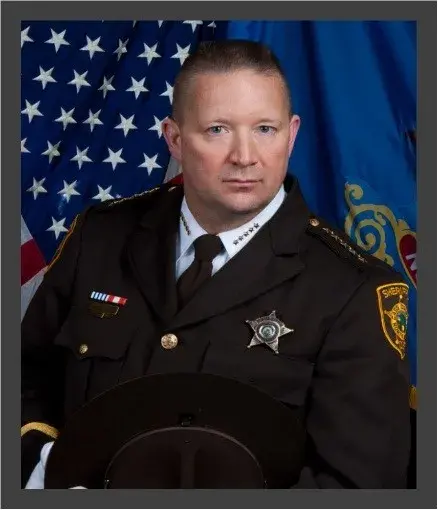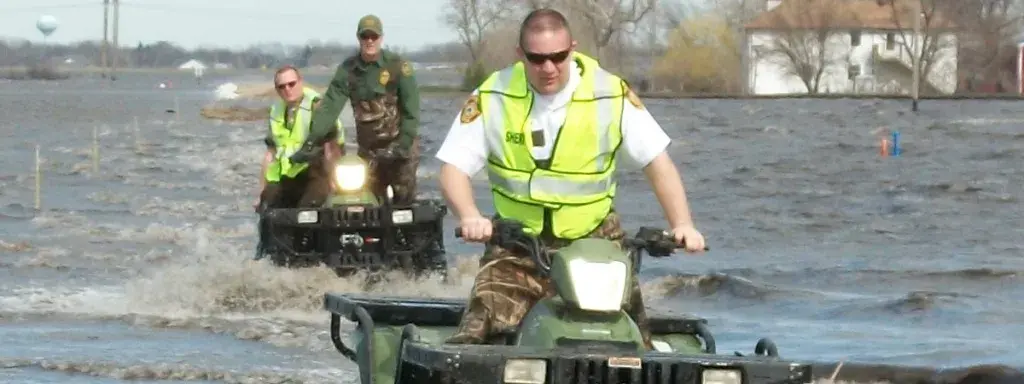The U.S. Department of Homeland Security (DHS) Science and Technology Directorate’s (S&T) First Responders Group (FRG) relies on experienced emergency response and preparedness professionals to guide its research and development efforts. The First Responder Resource Group (FRRG) fills that role. An all-volunteer working group, the FRRG helps S&T maintain focus on the top-priority needs of responders in the field. This series highlights several FRRG members, offering a glimpse into their daily responsibilities, as well as their ongoing support of S&T technology development.
 Meet Paul D. Laney, Cass County (North Dakota) sheriff, National Sheriff’s Association (NSA) board member, and FRRG advisor. While Laney has lived in Cass County (home to Fargo) for the majority of his life, he credits his military service for setting the tone for his life of service.
Meet Paul D. Laney, Cass County (North Dakota) sheriff, National Sheriff’s Association (NSA) board member, and FRRG advisor. While Laney has lived in Cass County (home to Fargo) for the majority of his life, he credits his military service for setting the tone for his life of service.
“I knew I always wanted to be a Marine,” Laney said. “So, after high school I enlisted, and spent four years with the U.S. Marine Corps.”
“It was the best decision I made,” he continued. “I truly credit the Corps with developing who I am as a leader and being able to take on anything that comes my way. I learned when and how to lead and be a confident leader people can count on.”
After his time serving with the Marine Corps, he spent more than 17 years on the Fargo Police Department doing everything from patrolling the streets to being a field training officer. During his tenure there, he was promoted to lieutenant and became the commander of the local tactical unit. He later led the Red River Valley SWAT team.
Laney enjoyed his time with the Fargo Police Department, but after a while began looking for a change. He earned a master’s degree in management from the University of Mary in Bismarck in 2005 and sought new opportunities in law enforcement.
“I was looking to run my own agency, and I knew the sheriff’s office would fit me well because I like talking to people. I ran for office in 2006 and am now in my third term.”

“Anyone who knows me knows I have a deep passion for public service. As sheriff, I belong to the public
and have a responsibility to do the best job I can and encourage my agency to do the same.”
For Laney, there is no such thing as a typical day. “When you work for the public, you have to be accessible and accountable to your community and adaptable to changes in the field,” he said. “Every day I get to serve is an absolute privilege for me, and it’s something I have to earn.”
“One of my captains calls me the ‘hair on fire’ guy because I like to be on the cutting edge. The worst thing I can hear is ‘we’ve always done it this way.’ I push myself and my agency to try to be more helpful to my community—the public deserves that.”
He is proud that his team comes together to answer every challenge they’ve faced, including major incidents in the Cass County area that tested his department and skills. For example, in early 2011 the department stood up its Tactical Operations Center (TOC) in response to record flooding in the Red River Valley region. The TOC helped coordinate emergency response among several agencies at multiple levels of government, including the North Dakota Highway Patrol and the United States Coast Guard. During the response, the TOC used smart board technology to allow emergency responders to pull up photos of every home and road in the county. The efforts with the TOC were recognized by the Federal Emergency Management Agency Region 8 Administrator as a best practice applicable across the U.S.
On December 30, 2013, a derailment 15 miles outside of Fargo left several train cars on fire and prompted an evacuation of the area. As Laney recalls, “Our training and preparedness efforts kicked in, and we took care of it. I’m so proud of our ability to be ready. Readiness is not something that you can just say in name; you have to follow it up with your actions.”
“We truly have the 'A' Team here,” he added. “I hold them up as a role model agency against any law enforcement agency around the country. No one person did that; it was teamwork. We answered the call—the Cass County Sheriff’s Department is on duty, and people can sleep easy.”
Laney was encouraged to join the FRRG by former NSA chairman Sheriff Paul Fitzgerald, who was also a member. He submitted an application and was accepted in 2012. He attended the 2015 FRRG meeting in New Orleans and participated in the Cyber, Decision-Making Support, and Incident Management Working Group, which considered how to incorporate information from various sources [e.g., crowd sourcing and social media] into incident command and operations. “It was impressive to see all these first responder minds come together. Some folks are more operationally sound or have more of a technical background. When those groups mix, there is a great dynamic,” Laney said.
Laney’s involvement with the FRRG has expanded his view of available technology, provided networking opportunities, and offered a place to talk with other first responders about different equipment and technology. As a member of both the FRRG and the NSA, he also functions as a liaison between the two groups, communicating concerns and bringing information and lessons learned back and forth.
“What also really resonated with me this year was hearing about Finding Individuals for Disaster and Emergency Response (FINDER) being used in Nepal. It’s nice to know you’re making a difference and that your contribution comes to fruition, and you’re not just daydreaming around a table.”
Check back soon for additional FRRG member spotlights. For more information on how to become a member of the FRRG, contact first.responder@hq.dhs.gov.
